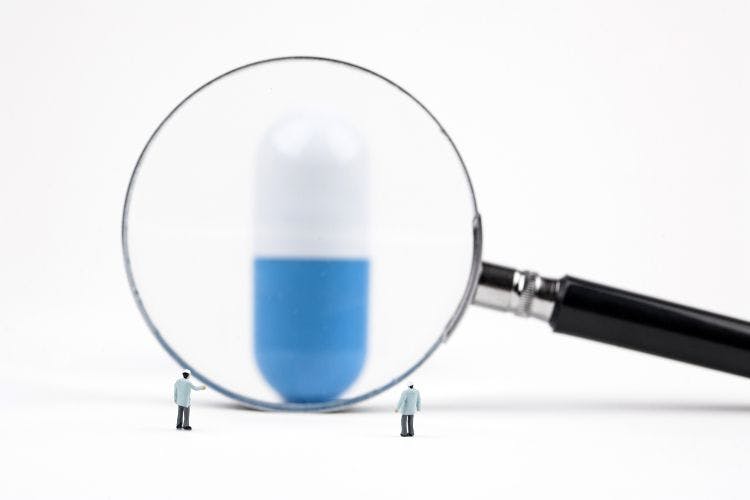Nutritional Outlook’s 2018 Best of the Industry Awards, Industry Leader: Supplement Safety Compliance Initiative
Driven by retailers, SSCI is harmonizing industry standards through benchmarking to ensure product quality, transparency, and traceability.
Photo © Shutterstock.com/nerosu

In recent years, self-regulation has become a key dietary supplement industry priority. While many manufacturers have incredible reputations because of their long history of ensuring quality and safety, it has become clear that the most effective way to earn respect as an industry is to come together as one. That is why Nutritional Outlook is recognizing two self-regulatory initiatives: The Supplement Safety Compliance Initiative (SSCI) and the Global Retailer and Manufacturer Alliance (GRMA).
A sentiment shared by parties involved in both of these initiatives is that quality and safety are not competitive advantages for companies to leverage against others, but an ethical responsibility shared by all. That is the remarkable thing about SSCI and GRMA, that they each brought together stakeholders from across the industry-competitors, in most cases-to collaborate and develop high standards they can all agree on. Each offers a distinct self-regulatory pathway-SSCI, through benchmarking, and GRMA, through an entirely new standard-but they are not in conflict with one another; rather, they each have a valuable place in how the industry will regulate itself and collectively pursue a higher quality standard moving forward.
Supplement Safety Compliance Initiative
Retailers are at the front lines of the dietary supplement industry interacting with customers. This also makes them vulnerable to recalls and enforcement actions because they are the gatekeepers of finished products to consumers. After the actions taken by then–New York Attorney General Eric Schneiderman in 2015 against four national retailers that saw retailers pull herbal supplement products off their shelves and led to investigations by state attorneys general throughout the nation, the industry learned that it needed to demonstrate that consumer safety is priority one and to take substantive measures to demonstrate its commitment to safety. This has led to the creation of the retailer-driven Supplement Safety Compliance Initiative (SSCI), spearheaded by major retailers like GNC and Walmart, in partnership with the Natural Products Association (NPA).
SSCI was kicked off by Dadrion Gaston, R.Ph, CCEP, CHC, senior director, corporate compliance for Walmart, and Guru Ramanathan, chief innovation officer at GNC. “[They realized] we need to set up a Global Food Safety Initiative (GFSI)-type system by the industry for the industry…We need to set up a system where we know we are covering the industry,” explains Daniel Fabricant, PhD, president and CEO of NPA. FDA does not have the resources to inspect every facility, so it is up to the industry to instill trust by creating a more consistent and streamlined system. “FDA on its own side may get to 5% of [food manufacturing] facilities out there, but you never hear that the grocery industry is unregulated, because so much is done through GFSI and self-regulation in that regard,” Fabricant says. “So, what we really wanted to get to was a system that says we understand that FDA can’t solve all our problems, we’re not looking for FDA to solve our problems, we’re going to show that they can have confidence in the industry, and here’s how.”
Among the key concerns expressed by the New York Attorney General at the time were that sufficient quality-control measures did not exist to ensure product authenticity and purity at manufacturers and retailers, that standard chemical testing approaches did not provide adequate assurances of authenticity, and that there was no federal requirement for contaminant testing to ensure the safety of products. Upon investigating these matters themselves, industry leadership found that there were gaps in guidelines available to the industry, specifically regarding raw materials such as botanicals and synthetics, that have led to a lack of harmonized standards, impacting quality, authenticity, traceability, and transparency of the supply chain. They also found that there was not much consistency in audit criteria for finished-product facilities, creating variability in ratings and certifications between different auditors.
Ultimately, there was no comprehensive system to provide end-to-end transparency in the supply chain. Modeled after GFSI, SSCI provides a voluntary pathway to supplement safety certification of the entire supply chain through a harmonized benchmarking process. Driven by retailers, SSCI also brings manufacturers, auditing bodies, and trade associations into the fold. “It’s a coalition of the willing,” says Fabricant.
Benchmarking
A benchmark is the minimum standard of equivalence that another standard is held to. Dietary supplements are required by the U.S. Food and Drug Administration to comply with current good manufacturing practices (21 CFR Part 111), and a variety of third-party certifiers will audit facilities to verify they comply with said standards. Retailers may also request audits of manufacturing facilities to make sure they comply and reduce their liability. Unfortunately, this has led manufacturers to receive multiple, redundant audits that are costly. Not only that, but because of the lack of consistency, each audit can render different results.
Ramanathan remarked at November’s SupplySide West show that GNC’s manufacturing facility was recently subject to 28 audits in one year, and despite the audits being conducted a few months apart by the same audit body, because it was a different person conducting the audit, the facility would receive a different score each time. Therefore, through benchmarking, SSCI seeks to recognize multiple certifiers who meet its standards so that participating retailers and brand owners can be confident about the quality, transparency, and traceability of products, and because it is recognized by multiple parties, reduce the frequency of audits as well as inconsistencies between audits.
The benchmarking process essentially allows SSCI to act as a third-party certifier of third-party certifiers. “A certification body would submit a certification scheme that they want to benchmark to get evaluated by the benchmark committee,” explains Fabricant. “The benchmark committee is effectively a team of industry experts-different folks from different companies that look at the scheme and everything that underlies that scheme with respect to auditor training, qualification, all the way through to conducting the audit and then re-evaluation: is this a program that has continuous improvement?”
The need to learn and improve is key. SSCI has this built into its benchmark, using data from its recognized certifiers to determine shortcomings and address them. “The benchmarking doesn’t just happen once; you’ve got to do it every year,” explains Fabricant. “That’s the advantage, too, after a year, that the benchmarking committee has data about how that certification scheme performed.”
It’s significant to note that SSCI covers the entire supply chain with a number of scopes that cover not only the manufacturing of finished products but also raw materials, including GMPs for synthetic raw materials, Good Agricultural & Cultivation Practices (GACPs), and GMPs for botanical raw materials, as well as the identification and testing of probiotics, to name a few. In the future, SSCI will expand to cover scopes such as wild crafted herbs and the processing of finished supplement products, the processing of plant and animal perishable products, and delivery formats.
In order to develop benchmarks for these various scopes, SSCI relied on a number of resources, developing them with the collaboration of a number of industry stakeholders. At its core, the benchmark relied on the law, specifically 21 CFR 111 for finished products and 21 CFR 117 for raw materials, because that is the legal standard all facilities must comply with. Beyond this, SSCI utilized the expertise of auditors, quality assurance and quality control experts, as well as former FDA inspectors in its committees and working groups tasked with developing the benchmark standards and audit guidance.
Besides U.S. law and standards, the benchmarks also utilized global resources. For example, when developing the botanical GACPs and GMPs, SSCI’s global resources included guidance from the Therapeutics Goods Administration in Australia, Health Canada, the U.S. FDA, the Word Health Organization, the European Commission, and the American Herbal Products Association. Botanical material processors, botanical supply chain experts, and botanical identity experts were among the experts who were involved in drafting the standard.
“It was a great collaboration between the different certifiers, between UL, between USP, between Eurofins, and other groups, people who have been doing this a long time,” says Fabricant. “[They] threw all that experience in the middle of the table and then it got shaken up a bit. How it got shaken is the best part: the pilot audits. Draft templates and draft tools were developed to find out what the audit needs to be, [regardless of] whether it’s an audit done by someone with a few years’ experience or 25 years’ experience.”
These pilot audits were crucial in determining how discrepancies occurred between different audits, even when all other factors remain the same. “In the same day, you had three auditors auditing the same facility using the same audit tool and we figured out that there were a lot of discrepancies, not only in the audit findings, but also in how each auditor was auditing or rating the facility, so we were able to identify these gaps and what needed to be done. So the benchmarking committee that is focused on this particular area is focusing not only on standardization of the audits, but also on what minimum training needs to be,” explained Ramanathan at SupplySide West.
Among these discrepancies, explains Fabricant, is background. “One of the things we found was that if someone had some training in microbiology versus if somebody had more of a chemistry background. The chemistry folks tended to spend more of their time on high-performance liquid chromatography, and the micro people tended to spend more time on the microbiology aspects,” he said. “So that made us be very specific with instruction in the guidance to the inspector to say there needs to be a balance.”
In tackling the audit of raw materials and farms, a similar tool was developed, and the pilot audits garnered similar results. “This is very powerful for us, and we are now looking to figure out what is the appropriate tool for an audit body to conduct and audit at a farm and at a raw material manufacturing facility,” said Ramanathan. “A lot of great work has just been started. The teams that are involved in this process are providing deep knowledge and expertise in making sure that we are able to make quick progress.”
Paving the way for SSCI, Ramanathan has also stated that GNC, because it is in the unique position of acting both as a retailer and manufacturer, will become the first SSCI certified facility. GNC will also require finished-product manufacturers who wish to retail their products at GNC to manufacture them in SSCI-benchmarked facilities.




















